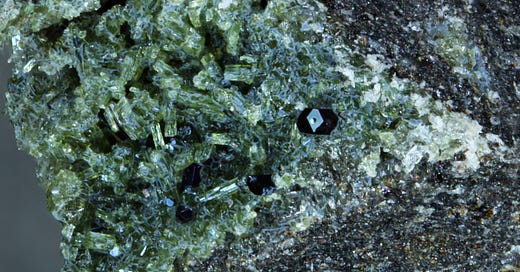The name "aenigmatite" comes directly from the Ancient Greek word αἴνιγμα (aínigma), meaning "riddle" or "enigma". Why is this?
Aenigmatite was named by the German mineralogist August Breithaupt in 1865. Breithaupt chose this name because, at the time of its discovery and initial study, its chemical composition and crystal structure were exceptionally unusual and difficult to determine. It presented a true "riddle" to mineralogists.
Aenigmatite is a silicate mineral, formula Na4[Fe2+10Ti2]O4[Si12O36], and typically occurs as black opaque crystals. It can sometimes be confused with other dark minerals found in similar environments, such as arfvedsonite or aegirine. Its reddish-brown streak is often the first clue for identification without analysis.
Aenigmatite is a relatively rare mineral, typically found only in a specific type of igneous rock: peralkaline igneous rocks. These are rocks that are unusually rich in alkalis (sodium and potassium) compared to aluminium. Examples include nepheline syenites, alkali granites, and phonolites.
The Co-Type Localities are:
Kangerluarsuk Fjord, Ilímaussaq complex, Kujalleq, Greenland
Naujakasik (Naajakasik), Tunulliarfik Fjord, Ilímaussaq complex, Kujalleq, Greenland
Below: Aenigmatite, Middle Hill, Mount Anakie, Anakie, City of Greater Geelong, Victoria. Width of view 3mm. Click on the image for a higher resolution version.




